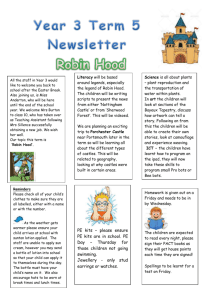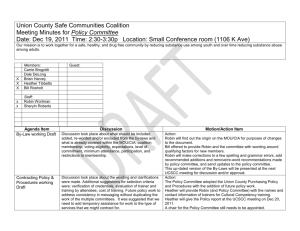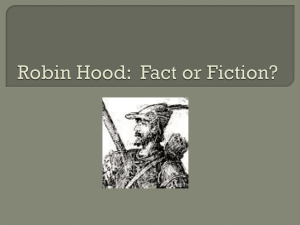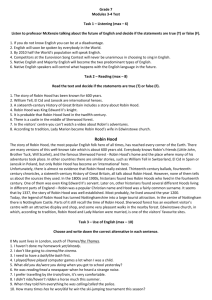CRIME AND PUNISHMENT IN THE MIDDLE AGES WAS ROBIN
advertisement
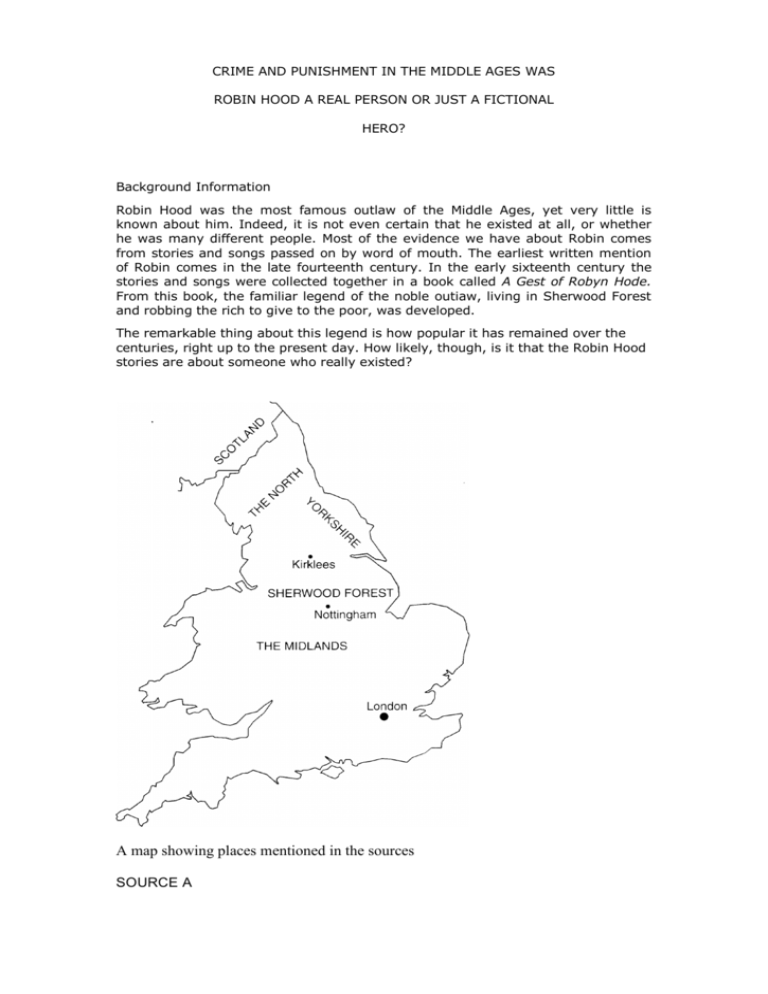
CRIME AND PUNISHMENT IN THE MIDDLE AGES WAS ROBIN HOOD A REAL PERSON OR JUST A FICTIONAL HERO? Background Information Robin Hood was the most famous outlaw of the Middle Ages, yet very little is known about him. Indeed, it is not even certain that he existed at all, or whether he was many different people. Most of the evidence we have about Robin comes from stories and songs passed on by word of mouth. The earliest written mention of Robin comes in the late fourteenth century. In the early sixteenth century the stories and songs were collected together in a book called A Gest of Robyn Hode. From this book, the familiar legend of the noble outiaw, living in Sherwood Forest and robbing the rich to give to the poor, was developed. The remarkable thing about this legend is how popular it has remained over the centuries, right up to the present day. How likely, though, is it that the Robin Hood stories are about someone who really existed? A map showing places mentioned in the sources SOURCE A A picture of Robin Hood from a book called Bold Robin Hood and his Outlaw Band: Their Famous Exploits in Sherwood Forest'. published in 1912. Robyn very good bow, An arrow he drew at will; He so hit the proud sheriff That upon the ground he lay quite still And before he could rise, On his feet to stand, early century. He struck off Sixteenth the sheriff's head With his bright blade. And always went good Robyn Both by hideout and by hill And always slew the king's deer And dealt with them Source C at his will Source B From A Gest of Robyn Hode, published in the early 16th century About this time (the II90s) there flourished those most famous robbers, Robert Hood, an Englishman, and Little John, who lay in wait in the woods but robbed only people who were wealthy. They killed only those who attacked them or who resisted them by refusing to give up their possessions. Robert was supported in his plundering by one hundred bowmen. The achievements of this Robert are told in song all over Britain. The robberies of this man I condemn but of all robbers he was the kindest and most gentle. From a History of Great Britain written by a Scottish historian and published in 1521. SOURCE E Source E There can be little doubt that the name Robin Hood originally belonged to a mythical forest-elf, who was important in English and in Scottish folk-lore. The name was afterwards used in English stories and songs from the twelfth to the fifteenth centuries, mostly in the North and the Midlands. In these tales, any robber leader who made his home in the forests or moors, excelled in archery, defied the unpopular forest laws and thus attracted the sympathy of the ordinary people, was called Robin Hood. The entry for Robin Hood in the Dictionary of National Biography'. published in 1891. Source F It does not matter whether Robin Hood ever existed, and if so whether he lived in the thirteenth or fourteenth century. What concerns us is what people believed. The carefree life of Robin's outlaws in the forests so unlike the dangerous and miserable existence of real outlaws, may represent the ideal kind of life that the audiences of the stories would have liked to live. The forest was always seen in their imaginations as a place of freedom. A British historian writing about Robin Hood in 1996. Questions 1. Study source A What impressions of Robin Hood does this source give you? Use the source to explain your answer [6] 2. Study source B How far does this source approve of Robin Hood? Use the source to explain your answer [7] 3. Study Source C How useful is this source as evidence about Robin Hood? Use the source to explain your answer [9] 4 Study Source D. Is this picture reliable as evidence about where Robin Hood was buried? Use the source and your knowledge to explain your answer. [9] 5 Study Sources E and F. How similar are these two sources as evidence about Robin Hood? Use the sources and your knowledge to explain your answer [9] 6 Study all the sources. Do these sources show that Robin Hood was a real person? Use the sources and your knowledge to explain your answer. Remember to identify the sources you use. [10] 1985i22 Jun05

